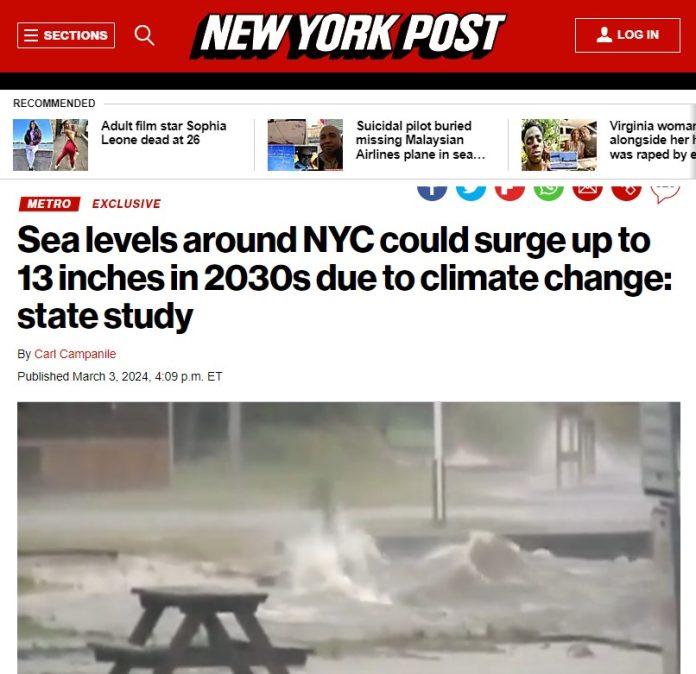A story published in the New York Post (NYP) on March 3rd 2024 by Carl Campanile has the alarming headline: Sea levels around NYC could surge up to 13 inches in 2030s due to climate change: state study. The story and study cited is false, because it relies on an impossible climate model scenario known as RCP8.5, which has been debunked by actual climate scientists as we reported here and here.
Surprisingly, just a day later on March 4th, 2024 the editorial board of the NYP published this headline: NYS DEC’s ‘sky is falling, seas are rising’ lunacy. Both stories are about the same report, an assessment done by the New York state Department of Environmental Conservations (NYDEC), which claimed that sea levels could rise by more than a foot in some areas around New York City in a decade or less.
With dueling headlines a day apart, it’s hard to really know what the position of the NYP is, but of the two, the latter headline is far more measured and realistic.
As mentioned previously, the RCP8.5 climate model used to make these claims is implausible if not impossible, and has come to be accepted in the climate scenarios community as being an unrealistic projection.
To give you an idea of just how unrealistic this model projection is, lets examine one of the oldest records on sea level in the United states, The Battery tide gauge in New York City from the National Oceanic and Atmospheric Administration (NOAA). This record shows a constant and mild sea level rise going back over 150 years:
NOAA says this about the data in that chart:
The relative sea level trend is 2.92 millimeters/year with a 95% confidence interval of +/- 0.09 mm/yr based on monthly mean sea level data from 1856 to 2023 which is equivalent to a change of 0.96 feet in 100 years.
In other words, it would take just over 100 years for sea level to rise by an additional one foot in New York City. Yet, there are the claims of 13 inches of rise in about 10 years, according the the NYP article citing NYDEC. For that to occur, sea level would have to start rising at over 10 times the current rate as displayed by the data at The Battery tide gauge shown above. This is extremely unlikely if not impossible, as sea level has never demonstrated such dramatic and immediate increases that would be required in the scenario outlined by NYDEC.
In a takedown of this absurd claim, climate scientist Roger Pielke Jr. Ph.D, had this to say in an essay, Bonkers in Yonkers:
You don’t have to be a climate scientist to see that SSP5-8.5 is far more extreme than the more plausible scenarios consistent with history and the projected near-term future to 2050. Extreme, implausible scenarios have their purposes, but are misused if prioritized as the basis for policy and planning.
…
The real world is not headed for a RCP8.5 future, which means that planning for a RCP8.5 world is not just misguided, but bad science, poor policy, and a waste of taxpayer money.
…
Whatever the understandings and motivations of these experts, the continued misuse of climate scenarios in New York is an example of regulatory capture by a small group of like-minded people who sit largely out-of-sight, protected by their authority and the inscrutable complexity of climate scenarios.
Clearly the claims made by NYDEC are completely out of line with reality. But worse than that, they’re not even looking at all of the data available. For example it has been known for quite some time that New York City is actually sinking due to the weight of its own infrastructure. Last year the NYP published this headline: NYC is sinking under the weight of its buildings, geologists warn. in that article it is stated:
New geological research warns that the weight of New York City’s skyscrapers is actually causing the Big Apple — whose more than 1 million buildings weigh nearly 1.7 trillion pounds — to sink lower into its surrounding bodies of water.
The city is plopping closer to the water at a rate of 1 to 2 millimeters a year, “with some areas subsiding much faster.”
This is from a peer reviewed publication from May 2023 in the American Geophysical Union journal Earth’s Future titled: The Weight of New York City: Possible Contributions to Subsidence From Anthropogenic Sources. In that publication abstract they say:
Geodetic measurements show a mean subsidence rate of 1–2 mm/year across the city that is consistent with regional post-glacial deformation, though we find some areas of significantly greater subsidence rates. Some of this deformation is consistent with internal consolidation of artificial fill and other soft sediment that may be exacerbated by recent building loads, though there are many possible causes.
It seems far more plausible that New York City is suffering under its own weight rather than being inundated by supposedly climate driven sea level rise based on an implausible or nearly impossible climate model such as RCP 8.5.
The media does everyone a disservice when they report on these wildly irrational claims of imminent sea level danger while ignoring the complete story of why at least half of it is actually happening. Further, they are unnecessarily alarming people by not looking at real world timelines of actual sea level rise such as The Battery tide gauge right there at the tip of Manhattan Island.
Such journalism is simply cheap and irresponsible without the entire story being reported.

















